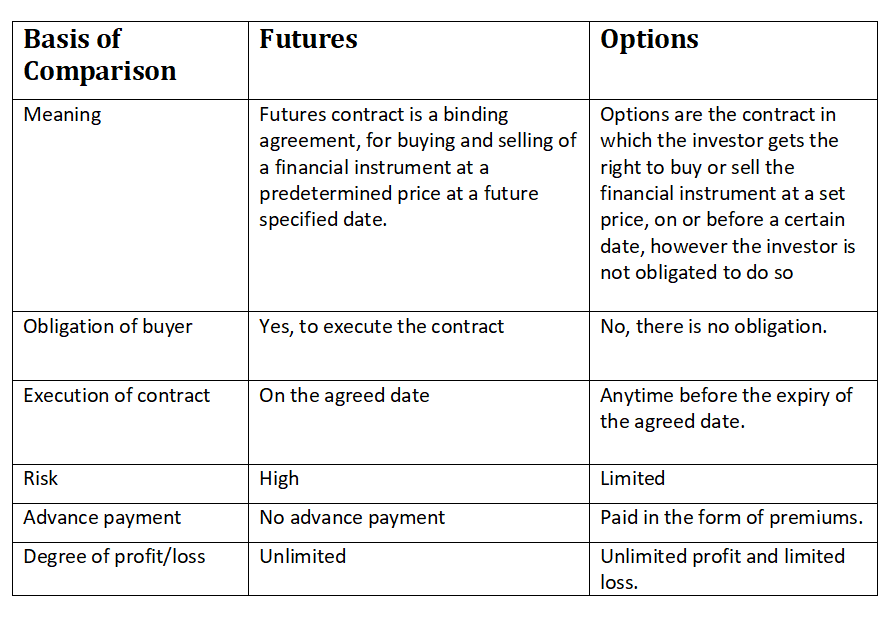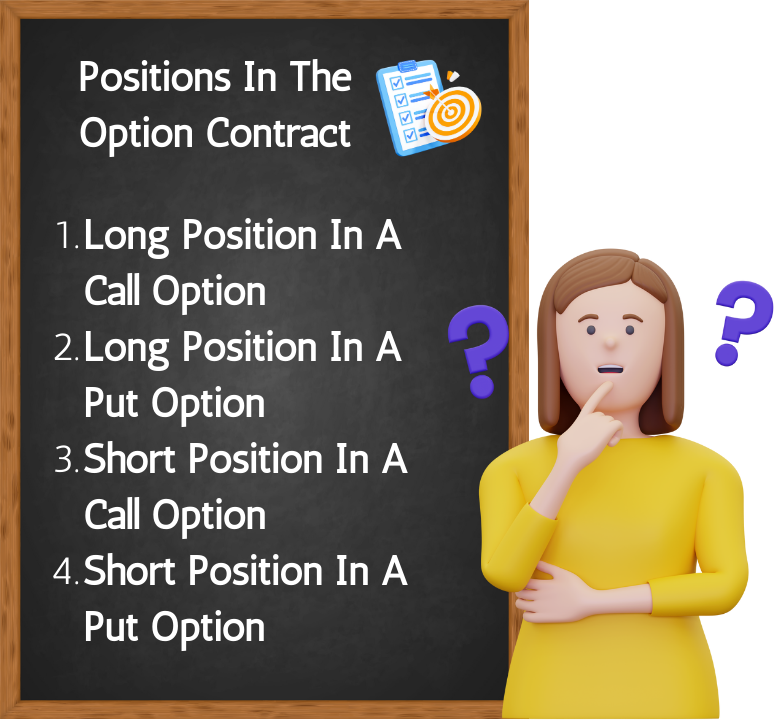- Study
- Slides
- Videos
7.1 Meaning Of Options

It is a contract whereby one party (the holder or buyer) has the right, but not the obligation, to exercise the contract (the option) on or before a future date (the exercise date or expiry). The other party (the writer or seller) has the obligation to honor the specified feature of the contract. Since the option gives the buyer a right and the seller an obligation, the buyer has received something of value. The amount the buyer pays the seller for the option is called the option premium
Because this is a security whose value is determined by an underlying asset, it is classified as a derivative. The idea behind an option is present in everyday situations. For example, you discover a house that you’d love to purchase. Unfortunately, you won’t have the cash to buy it for another three months. You talk to the owner and negotiate a deal that gives you an option to buy the house in three months for a price of Rs.10,00,000. The owner agrees, but for this option, you pay a price of Rs.30,000. Now, consider two theoretical situations that might arise:
- It’s discovered that the house is actually the true birthplace of a great man. As a result, the market value of the house skyrockets to Rs.50,00,000 Because the owner sold you the option, he is obligated to sell you the house for Rs.10,00,000. In the end, you stand to make a profit ofRs.37,70,000 (Rs.5000000-Rs.1000000-Rs.30000).
- While touring the house, you discover not only that the walls are chock-full of asbestos, but also that a ghost haunts the master bedroom; furthermore, a family of super-intelligent rats have built a fortress in the basement. Though you originally thought you had found the house of your dreams, you now consider it worthless. On the upside, because you bought an option, you are under no obligation to go through with the sale. Of course, you still lose the Rs.30,000 price of the option
This example demonstrates two very important points. First, when you buy an option, you have a right but not an obligation to do something. You can always the expiration date go by, at which point the option becomes worthless. If this happens, you lose 100% of your investment, which is the money you used to pay for the option. Second, an option is merely a contract that deals with an underlying asset. For this reason, options are called derivatives, which mean an option derives its value from something else. In our example, the house is the underlying asset. Most of the time, the underlying asset is a stock or an index.
7.2 Participants In The Option Market

There are four types of participants in options markets depending on the position they take: They are:
- Buyers of calls
- Sellers of calls
- Buyers of puts
- Sellers of puts
People who buy options are called holders and those who sell options are called writers: furthermore, buyers are said to have long positions, and sellers are said to have short positions. -Call holders and put holders (buyers) are not obligated to buy or sell. They have the choice to exercise their rights if they choose. -Call writers and put writers (sellers), however, are obligated to buy or sell. This means that a seller may be required to make good on a promise to buy or sell.
There are many different types of options that can be traded and these can be categorized in a number of ways. In a very broad sense, there are two main types: calls and puts. Calls give the buyer the right to buy the underlying asset, while puts give the buyer the right to sell the underlying asset. Along with this clear distinction, options are also usually classified based on whether they are American style or European style. This has nothing to do with geographical location, but rather when the contracts can be exercised.
7.3 Classification Of Options
Options can be further categorized based on the method in which they are traded, their expiration cycle, and the underlying security they relate to. There are also other specific types and a number of exotic options that exist.
A) Calls – Call options are contracts that give the owner the right to buy the underlying asset in the future at an agreed price. You would buy a call if you believed that the underlying asset was likely to increase in price over a given period of time. Calls have an expiration date and, depending on the terms of the contract, the underlying asset can be bought any time prior to the expiration date or on the expiration date.
B) Puts – Put options are essentially the opposite of calls. The owner of a put has the right to sell the underlying asset in the future at a pre-determined price. Therefore, you would buy a put if you were expecting the underlying asset to fall in value. As with calls, there is an expiration date in the contact.
C) American Style – The term “American style” in relation to options has nothing to do with where contracts are bought or sold, but rather to the terms of the contracts. Options contracts come with an expiration date, at which point the owner has the right to buy the underlying security (if a call) or sell it (if a put). With American style options, the owner of the contract also has the right to exercise at any time prior to the expiration date
D) European Style – The owners of European style options contracts are not afforded the same flexibility as with American style contracts. If you own a European style contract then you have the right to buy or sell the underlying asset on which the contract is based only on the expiration date and not before.
E) Exchange Traded Options – Also known as listed options, this is the most common form of options. The term “Exchanged Traded” is used to describe any options contract that is listed on a public trading exchange. They can be bought and sold by anyone by using the services of a suitable broker.
F) Over The Counter Options – “Over The Counter” (OTC) options are only traded in the OTC markets, making them less accessible to the general public. They tend to be customized contracts with more complicated terms than most Exchange Traded contracts.
G) Option Type By Expiration – Contracts can be classified by their expiration cycle, which relates to the point to which the owner must exercise their right to buy or sell the relevant asset under the terms of the contract. Some contracts are only available with one specific type of expiration cycle, while with some contracts you are able to choose. For most options traders, this information is far from essential, but it can help to recognize the terms. Below are some details on the different contract types based on their expiration cycle:
Regular Options: These are based on the standardized expiration cycles that options contracts are listed under. When purchasing a contract of this type, you will have the choice of at least four different expiration months to choose from. The reasons for these expiration cycles existing in the way they do is due to restrictions put in place when options were first introduced about when they could be traded. Expiration cycles can get somewhat complicated, but all you really need to understand is that you will be able to choose your preferred expiration date from a selection of at least four different months.
Weekly Options: Also known as weeklies, these were introduced in 2005. They are currently only available on a limited number of underlying securities, including some of the major indices, but their popularity is increasing. The basic principle of weeklies is the same as regular options, but they just have a much shorter expiration period.
Quarterly Options: Also referred to as quarterlies, these are listed on the exchanges with expirations for the nearest four quarters plus the final quarter of the following year. Unlike regular contracts which expire on the third Friday of the expiration month, quarterlies expire on the last day of the expiration month.
Long-Term Expiration Anticipation Securities: These longer term contracts are generally known as LEAPS and are available on a fairly wide range of underlying securities.
I) Employee Stock Options – These are a form of stock option where employees are granted contracts based on the stock of the company they work for. They are generally used as a form of remuneration, bonus, or incentive to join a company.
J) Cash Settled Options – Cash settled contracts do not involve the physical transfer of the underlying asset when they are exercised or settled. Instead, whichever party to the contract has made a profit is paid in cash by the other party. These types of contracts are typically used when the underlying asset is difficult or expensive to transfer to the other party.
K) Exotic Options – Exotic option is a term that is used to apply to a contract that has been customized with more complex provisions. They are also classified as Non-Standardized options. There are a plethora of different exotic contracts, many of which are only available from OTC markets. Some exotic contracts, however, are becoming more popular with mainstream investors and getting listed on the public exchanges. Below are some of the more common types:
Barrier Options: These contracts provide a pay-out to the holder if the underlying security does (or does not, depending on the terms of the contract) reach a pre-determined price.
Binary Options: When a contract of this type expires in profit for the owner, they are awarded a fixed amount of money
Chooser Options: These were named “Chooser,” options because they allow the owner of the contract to choose whether it’s a call or a put when a specific date is reached
Compound Options: These are options where the underlying security is another options contract.
Look Back Options: This type of contract has no strike price, but instead allows the owner to exercise at the best price the underlying security reached during the term of the contract
7.4 Difference Between Futures and Options
7.5 Positions In The Option Contract
- Long Position In A Call Option – A person who buys a call option is said to have a long position in a call option. He purchases the right, but not the obligation to buy underlying asset at the stated exercise price at any time before the option expires. In short, long means buy.
- Long Position In A Put Option – A person who buys put option is said to have a long position in a put option. He buys the right, but not the obligation, to sell the underlying asset at the stated exercise price at any time before the option expires.
- Short Position In A Call Option – A person who sells a call option is said to have a short position in a call option. He sells the right to buy the asset.
- Short Position In A Put Option – A person who sells a put option is said to have a short position in a put option. He sells the right to sell the asset at a fixed price. He has the obligation to buy the underlying asset at the stated exercise price.





